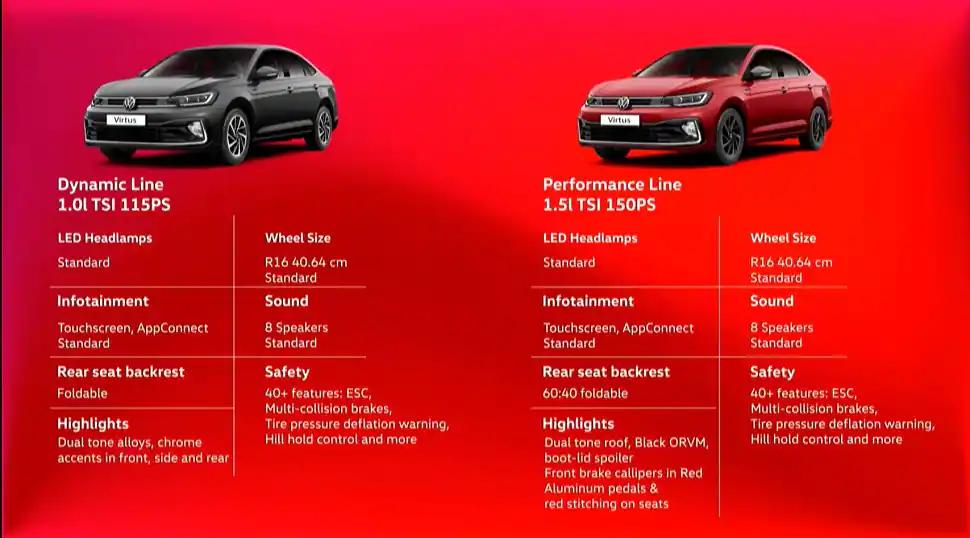Volkswagen Virtus is based on the heavily localised MQB A0 IN platform and it will be powered by the 1.0-litre and 1.5-litre petrol engines found in the Taigun
Following a set of teaser images, Volkswagen’s India division has today lifted the cloaks off the all-new Virtus sedan. The midsize model is the second VW spawned out of the India 2.0 project and the fourth within the group as the Skoda Kushaq, Volkswagen Taigun and Skoda Slavia are already out in the domestic market.
The Volkswagen Virtus will compete against Honda City, Hyundai Verna, Maruti Suzuki Ciaz, Skoda Slavia and the upcoming Toyota Belta. It is underpinned by the heavily localised MQB A0 IN platform as more than one billion euro investment has been put into the revival strategy over the last three years and the Virtus is the latest to come out of it.
The Virtus is the biggest car in its segment with an overall length of 4,561 mm and has larger dimensions than most of its rivals. It is expected to be priced competitively upon arrival as the price range could hover around Rs. 11 lakh to Rs. 19 lakh (ex-showroom) and the official market launch will happen in the third week of May 2022.

| VW Virtus Dimensions | Measurements |
| Length | 4,561 mm |
| Width | 1,752 mm |
| Height | 1,507 mm |
| Wheelbase | 2,651 mm |
| Bootspace | 521 litres |
The Virtus will also be available in the Latin American market and since the nameplate is already on sale there, it will act as a facelift. The five-seater has plenty in common with the recently launched Skoda Slavia as they share body panels, interior bits and technologies to save costs involved in production. Upon launch, the Virtus will replace the Vento that was retailed for well over a decade in India.
| VW Virtus Specifications | Details |
| Engine | 1.0L Turbo Petrol/1.5L Turbo Petrol |
| Power | 115 PS/150 PS |
| Torque | 175 Nm/250 Nm |
| Transmission | Six-Speed MT, Six-Speed AT, Seven-Speed DCT |
Since the Vento nameplate was widely renowned, the Virtus has a lot riding on its shoulders and despite the diminishing popularity for midsize sedans, VW and Skoda are banking big on the space. It is noticeably longer than Vento and has a longer wheelbase enabling a more spacious interior for the occupants along with a larger bootspace.
The VW Virtus follows the latest styling philosophy adapted by the German auto major globally with the presence of a sharp front fascia boasting a pair of sleek headlamps with integrated LED Daytime Running Lights, plenty of chrome treatment on the grille and bumper, C-shaped chrome fog lamp housings, and wide central air inlet.
Other visual highlights are muscular bonnet structure and an electric sunroof alongside the black finished roof and ORVMs, blackened 16-inch alloy wheels with red front brake callipers, integrated black rear spoiler on the boot, slightly smoked wraparound LED tail lamps, black shark fin antenna, aluminium pedals, contrast red stitching, etc in the Performance Line trim.
With pre-bookings open, the six colour options the Virtus will be sold are Reflex Silver, Curcuma Yellow (as in Taigun), Candy White, Grey, Wild Cherry Red, and Rising Blue. The Dynamic Line is the other grade the Virtus will be offered with having features like standard LED headlamps and eight-speaker audio, foldable rear seat backrest (60:40 in Performance GT Line), TPMS, ESC, multi-collision brakes, HHC, impact-absorbing door components, side impact protection beams on doors, and more.
The features list boasts a large 10-inch touchscreen infotainment system with wireless Apple CarPlay and Android Auto connectivity, cooled glovebox, rain-sensing wipers, wireless charger, height-adjustable headrests and driver seat, push-button start/stop, ventilated front seats, six airbags, digital instrument console, automatic climate control, cruise control, four USB ports, and so on.
It is powered by the 1.0-litre petrol and the 1.5-litre petrol engines as in the Slavia and Taigun. The smaller gasoline unit develops 110 PS maximum power and 175 Nm of peak torque while the latter kicks out 150 PS and 250 Nm. Both are paired with a six-speed manual transmission as standard with a six-speed torque converter automatic unit and a seven-speed DSG as an option.
The Virtus has been jointly developed by VW’s team in India and Germany. It will be manufactured at the Chakan production facility, which will act as a global manufacturing hub too as the midsize sedan will be exported to 25 countries across 5 continents underlining why it is called“The New Global Sedan”.
